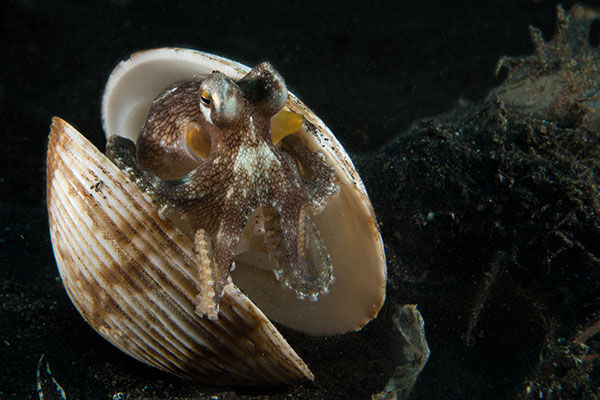Shells for a Home: The Coconut Octopus
- Youmna Hasanin
- Sep 25, 2020
- 3 min read
The Coconut Octopus earns its name from its unusual yet intelligent behaviour. Amphioctopus marginatus, also known as the 'coconut octopus' or the 'veined octopus' dwells in the tropical Pacific ocean which is surrounded by beaches lined with coconut trees. The coconut octopus has intriguingly gained the ability to understand how to gather coconut shells and other seashells to use for shelter. Sometimes, it will even carry those shells from place to place using their six arms, the remaining two being used for movement across the ocean floor.
Considered medium-sized, its body grows to an average of 8 centimetres long, and their arms are 15 centimetres on average. Similar to all other octopuses, the coconut octopus can also alter its colouration for camouflage. However, its normal colour is a reddish -brown body, patterned with dark lines that resemble veins - hence why it is often also referred to as

the 'veined octopus'. They have a yellow siphon, and extremely white suction pads. They are also identified by their webbing; it goes much further towards the tips of the arms than most other octopuses. This gives the coconut octopus a parachute-like appearance.
For such a small octopus, carrying shells (sometimes they'd even carry two halves of one shell) that are often bigger than themselves must be quite difficult. An alternative way of carrying those shells from place to place with their six arms, some coconut octopuses would be almost sitting on their shells and supporting them with two arms on either side. They would use the remaining six arms to drag themselves across the seabed (similar to skiing except there are 6 arms instead of 2 involved). Their style of movement has been named as 'Stilt Walking'.

This style of movement does not seem to be the most effective way of manoeuvring through the shallow ocean floors, particularly due to the uneven floor and the presence of many obstacles/rocks preventing the shells from gliding gracefully across. However, the coconut octopus can pull the shells shut at any moment, instantly protecting themselves from any predators. In this case, intelligence beats strength, as although some predators may be strong enough to break into the shells, most of them wouldn't actually be intelligent enough to do so. The coconut octopus was the first invertebrate to be recorded using tools such as these, in particular carrying them around. Many octopuses have been sighted inhabiting shells, however the coconut octopus remains the species which actually carries them around, like a portable home. Hence, the coconut octopus are considered one of few sea creatures that have learnt tool use.

Just like most other octopus species, the coconut octopus lives off a diet that includes invertebrates such as shrimp, crabs and clams, although it will also eat small fish if it can catch them. Their favourite times of day for hunting is dusk and dawn, and they feed by either grabbing their prey with their arms or smothering it with their skirt (the webbed areas between their arms). Just like all other octopus species, the coconut octopus has a venomous bite, and one bite will quickly paralyse its prey. They can also use their beak to drill into hard shells like clams, and inject their venom before sucking the paralysed animal out of the drill hole. Although they are venomous, the venom poses no threat to humans, unlike their more infamous relative, the 'blue-ringed octopus’, which we will research and explore in a different article.
References





Comments